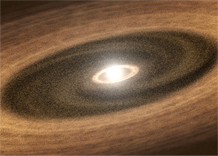
Exoplanet research could help unravel mysteries of our own planet
Astronomers research into exoplanets could hold key to riddle of Earth’s past
Pioneering research from University of Exeter scientists into the atmospheres of planets found beyond our own solar system could also help solve one of the greatest riddles of Earth’s past.
Astrophysicists from the College of Engineering, Mathematics and Physical Sciences have been using the Met Office’s Unified Model – which simulates Earth’s weather and climate - to look at a specific subdivision of exoplanets, or planets that revolve around stars other than our own.
Called ‘hot Jupiters’, these exoplanets are the size of our own neighbouring planet Jupiter, yet orbit their own stars more closely that Mercury does to the Sun, resulting in atmospheric temperatures of between 1000-3000 degrees Celsius.
Adaptations to the Met Office Model required for the study of hot Jupiters will also result in the possibility of the model being applied to a wider range of climate scenarios. In particular, Exeter scientists are hoping to study the climate of the young Earth, and in particular investigate the long-standing scientific puzzle known as the “faint-young Sun” paradox.
Dr Nathan Mayne, from the University of Exeter explained: “The astrophysics team are collaborating with Professor Tim Lenton and his group at Exeter’s Earth Systems Science group to investigate this challenging paradox.
“We know that, due to the evolution of the Sun, the early Earth received around 20 per cent less energy from the Sun than today. Existing, simplified, one dimensional radiative transfer models predict that water on Earth should have been completely frozen at this time. However, this is in contradiction to evidence from the fossil record.
“We think that some missing source of opacity – such as greenhouse gases or effects due to photochemistry - could be responsible for keeping temperatures higher, by acting rather like an extra blanket over the Earth. The tools we are developing as part of our research into exoplanets could provide a better understanding.”
The research is also looking at the possible state of the exotic climates of hot Jupiters. Where immense tidal forces, like those the Moon raises on Earth, for the planets into a synchronised rotation-orbit state, resulting in permanent 'day' and 'night' sides.
This means that the sheer intensity of radiation from the parent star results in extreme temperatures on the ‘day’’ side, in contrast to a very cold ’night’’ side where the heat can escape to space.
The resulting changes in temperature, of around 1000 degrees Celsius (compared to around 40 degrees between Earth’s equator and pole) drive extremely fast winds of several kilometres per second.
Scientists have been performing tests of Earth-like systems, including a tidally-locked Earth with a permanent day and night side, to increase confidence in the model functionality when used to study more extreme conditions than found on Earth. They have also conducted the first tests of a simple, idealised hot Jupiter atmosphere.
Dr Mayne said: “There are several immediate puzzles revealed by the observations of hot Jupiters.
“For instance, some of these planets appear much larger than predicted by evolutionary models, which we think may be caused by heating of the deeper layers of the atmosphere, while observations also suggest the presence of atmospheric aerosols, or dust particles, in the atmospheres of some hot Jupiters.
“The existing radiative transfer scheme within the Unified Model is being developed and adapted, by the University of Exeter team, to provide coupled models, helping to explore the deposition of heat as a function of depth in hot Jupiter atmospheres.”
The University of Exeter has one of the UK’s largest astrophysics groups working in the fields of star formation and exoplanet research. The group focuses on some of the most fundamental problems in modern astronomy – when do stars and planets form and how does it happen? They conduct observations with the world’s leading telescopes and carry out numerical simulations to study young stars, their planet-forming discs, and exoplanets.
This research helps to put our Sun and the solar system into context and understand the variety of stars and planetary systems that exist in our Galaxy. Through its science strategy, the University has invested £230 million of internal and external income in five key themes of activity, one of which is Extrasolar Planets.
Exeter’s research on exoplanets recently featured in the 2014 BBC Stargazing Live miniseries, hosted by Professor Brian Cox and Dara O’Briain.
Date: 28 January 2014
